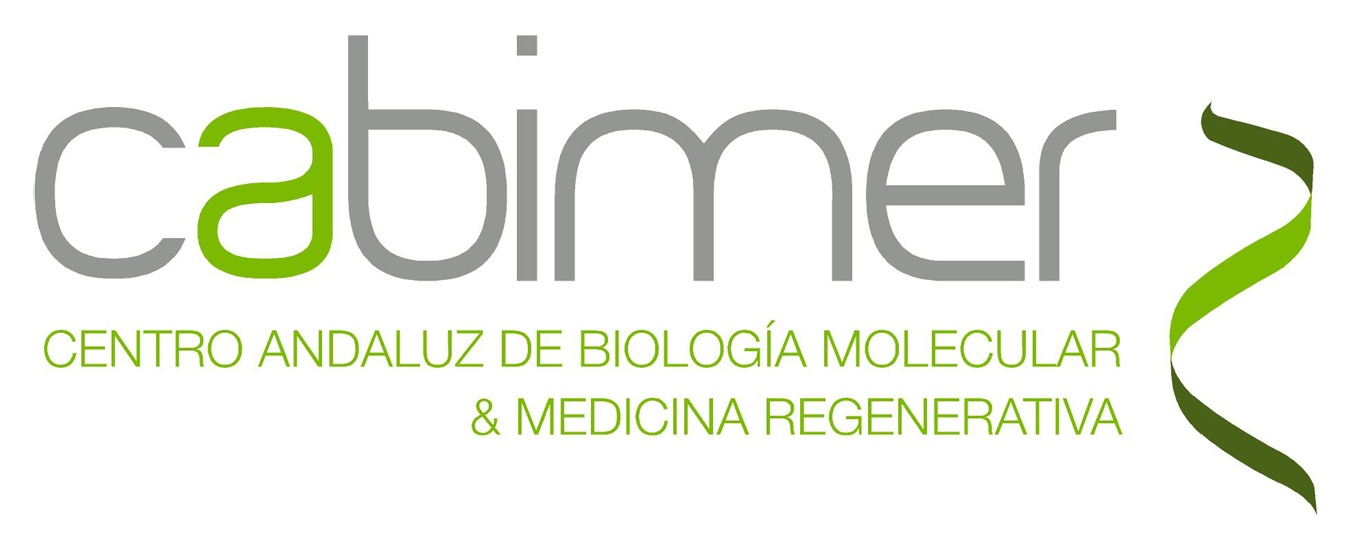Genomic Unit
The main objective of the Cabimer Genomics Unit is to provide services to both internal and external researchers through various technological approaches related to Functional Genomics.

Dra. Eloísa Andújar Pulido
Dra. Mónica Pérez Alegre
Dra. Lola Pérez de Camino Cantos
Victoria Jiménez Santos
Genomics is a branch of biology aimed at studying genomes on a global scale. Today, a genome is understood as the hereditary material of an organism, including all its genes and non-coding regions. Only a fraction of the genetic information within a cell is active or expressed at a given time. Differences in genome expression are responsible for the phenotypic variations among organisms.
Sequencing a genome is the first step toward Functional Genomics, a field that seeks to understand the genome’s function on a global scale and its impact on an organism’s development and physiology.
The ability to characterize gene function across different organisms using high-throughput strategies—such as gene expression profiling through microarrays, phenotypic analysis of mutants, or protein interaction studies—has become essential in biological and biomedical research. Similarly, the characterization of microsatellites or single nucleotide polymorphisms (SNPs) associated with specific phenotypes and diseases has opened new opportunities in biomedical research.
In recent years, DNA biochips or microarrays, followed by massive sequencing techniques (NGS), and more recently, Single Cell technologies, have become essential tools for genome and transcriptome analysis. To support these studies, Cabimer has adopted multiple platforms (Affymetrix, Illumina, and 10X Genomics), which are continuously evolving to meet the daily demands of scientific research, enabling studies on gene expression, chromatin, epigenetics, and more.
– Massive Sequencing Service – NGS (Next Generation Sequencing, Illumina)
- Transcriptomics (RNA SEQUENCING): Total RNA-Seq, mRNAseq, Small RNA-Seq, Ribo-Seq, RNA-Exome-Seq, targeted RNA-Seq…
- Single-Cell Sequencing: Single-Cell gene expression (scRNA-Seq and scRNA-Seq PLEX),
Single-Cell ATAC (scATAC-Seq), Single-Cell Multiome (simultaneous scRNA-seq + ATAC-seq), Single-Cell CRISPR Gene expression (CRISPR screening). - Genome Sequencing: Whole-genome sequencing
(WGS), De novo sequencing, Whole-exome sequencing (WES), Target Capture (custom panels, disease panels, etc.). - Epigenomics: Chip-Seq, ATAC-Seq, Mnasa-Seq, 3C, 4C, RIP-Seq, DRIP-Seq, DRIPc-Seq.
- Metagenomics: 16S sequencing,
Shotgunsequencing
For more details, please refer to the User Guideor contact the unit.
– Single-Cell Analysis Service (Single Cell Sequencing, scRNA-Seq, scATAC-Seq)
This technology is based on the individual encapsulation of cells into microdroplets, allowing the genetic material of each cell to be uniquely labeled and enabling large-scale sequencing analysis.
For the catalog of available applications (in addition to those listed above), please visit the 10x Genomicswebsite. . For sample requirements, please consult the unit, as information and applications are constantly updated.
– Microarrays Expression and CytogeneticsService (Affymetrix)
The Cabimer Genomics Unit offers the following microarray applications:
Gene Expression Microarrays (Refer to the User Guide):
- Traditional gene expressio studiesstudies using microarrays with probes designed for the 3′ region of transcripts(“3’ IVT Arrays“ or “Prime View”).
- Whole-transcriptome studiesstudies using microarrays with probes spanning entire genes in exons (“Gene arrays/
Clariom S”) or both exons and introns, enabling splicing variant analysis (“Clariom D”). - small-RNA studies (“GeneChip miRNA 4.0 Assay”)” for analyzing miRNA-mediated mechanisms,pre-miRNA, snoRNA, scaRNA, and more than 203 organisms in a single assay.
Molecular Cytogenetics Microarrays (Refer to the User Guide):
- Molecular cytogenetics studies (“CytoScan Array”)with high sensitivity, specificity, and resolution for detecting chromosomal abnormalities in quality control of cell lines (including stem cells), prenatal studies, tumor cells, etc. These allow the detection of abnormalities such as submicroscopic aberrations, copy number variations (CNVs), gains and losses, uniparental disomy, and mosaicism.
– Nucleic Acid Quality and Quantity Analysis Service
- DNA/RNA quality analysis using automated electrophoresis (Bioanalyzer/ TapeStation). for more details, consult the User Guide or contact the unit
- Fluorometric quantification of DNA/RNA (QubitTM). For more details, user Guide or contact the unit
Scientific Applications Covered by These Services
- Single-Cell Massive Sequencing Analysis: scRNA-SEQ, scATAC-SEQ, Multiome (ATAC + GeneExpression).
- Massive Sequencing: RRNA-Seq, ChIP-Seq, DNA-Seq, mutation screening, circulating DNA, cancer studies, hereditary disease studies.
- Quality (Integrity) Analysis and DNA/RNA Quantification as a preliminary study for RT-qPCR, sequencing, microarrays, etc.
- Comparative gene expression profiling under different experimental conditions for all types of eukaryotic and prokaryotic organisms.
- Splicing event studies associated with gene expression.
- miRNA analysis (pre-miRNA, snoRNA, lncRNA…) related to gene expression.
- DNA-protein interaction studies (ChIP-Seq…) and DNA-RNA interaction studies (DRIP-Seq).
- Copy number variation (CNV) detection and chromosomal alterations (CNVs and SNPs) in cell cultures, prenatal samples, fresh and paraffin-embedded human samples (including tumors), LOH studies (including molecular cytogenetics), CGH, trio studies, etc.
How to Request These Services
- Consult with the Genomics Unit (experimental design) and follow the User Guides instructions.
- Fill out the appropriate service request form and send it along with the samples. (Links available on the website)
- Upon sample/data reception, the user will receive a confirmation email.
- A preliminary quality control check of the samples/data will be performed before analysis, and the user will be notified of the results via email.
- For sample submission and requirements, please refer to the User Guides (for single-cell applications, it is essential to contact the unit beforehand). Contact: eloisa.andujar@cabimer.es; monica.perez@cabimer.es. Phone: +34 954 467828
To contribute to the scientific community’s research and support the development of these studies, the Cabimer Genomics Unit is equipped with the following recently expanded instrumentation:
- NovaSeq 6000 Next-Generation Sequencer from Illumina.
- NextSeq 500 Next-Generation Sequencer from Illumina.
- CHROMIUM CONTROLLER Single-Cell Analysis System from 10X Genomics for NGS.
- ION PERSONAL GENOME MACHINE (PGM™) SEQUENCER Next-Generation Sequencer from Life Technologies.
- GeneChip® Instrument System from Affymetrix for MICROARRAYS, consisting of:
- Hybridization Oven Model 645.
- Fluidics Station 450.
- Scanner 3000 7G with an autoloader for up to 40 cartridges and a laser with 532 nm excitation.
- MICROARRAY System from Agilent Technologies, including:
- Hybridization oven for printed Microarrays, Agilent model G2545A.
- GenePix 4100A Scanner from Axon for image analysis and fluorescence data quantification of Microarrays.
- Bionalyzer® 2100 from Agilent Technologies (with Vortexer MS S8/S9).
- TapeStation 4200 from Agilent Technologies.
- Qubit 2.0 Nucleic Acid Quantification System (Life Technologies).
- Nanodrop® ND-1000.
- RoToR HDA Colony Picker Robot from Singer Instruments.
- Microlab Star Robot from Hamilton for liquid handling.
Below is a list of publications in which the CABIMER Genomics Unit has participated:
- Bruno F, Coronel-Guisado C, González-Aguilera C.
Collisions of RNA polymerases behind the replication fork promote alternative RNA splicing in newly replicated chromatin.
Mol Cell. 2024 84(2):221-233.e6
doi: 10.1016/j.molcel.2023.11.036. - Casimiro-Soriguer CS, Pérez-Florido J, Robles EA, Lara M, Aguado A, Rodríguez Iglesias MA, Lepe JA, García F, Pérez-Alegre M, Andújar E, Jiménez VE, Camino LP, Loruso N, Ameyugo U, Vazquez IM, Lozano CM, Chaves JA, Dopazo.
The integrated genomic surveillance system of Andalusia (SIEGA) provides a One Health regional resource connected with the clinic.
Sci Rep. 2024 Aug 19;14(1):19200.
10.1038/s41598-024-70107-0. - Barrientos-Moreno M, Maya-Miles D, Murillo-Pineda M, Fontalva S, Pérez-Alegre M, Andújar E, Prado F.
Transcription and FACT facilitate the restoration of replication-couple chromatin assembly defects.
Sci Rep. 2023 Jul 14;13:11397.
doi: 10.1038/s41598-023-38280-w. - Marchena Cruz E, Camino LP, Bhandari J, Silva S, Marqueta-Gracia JJ, Amdeen SA., Guillén-Mendoza C, García-Rubio M, Calderón-Montaño JM, Xue X, Luna R, Aguilera A.
DDX47, MeCP2, and other functionally heterogeneous factors protect cells from harmful R loops.
Cell Reports. 2023 Mar 28;42(3):112148.
doi: 10.1016/j.celrep.2023.112148. - Gómez-Marín E, Posavec-Marjanović M, Zarzuela L, Basurto-Cayuela L, Guerrero-Martínez JA, Arribas G, Yerbes R, Ceballos-Chávez M, Rodríguez-Paredes M, Tomé M, Durán R, Buschbeck M, Reyes JC.
The high mobility group protein HMG20A cooperates with the histone reader PHF14 to modulate TGFβ and Hippo pathways.
Nucleic Acids Res. 2022 Sep 23;50(17):9838–9857.
doi: 10.1093/nar/gkac766. - Loucera C, Pérez-Florido J, Casimiro-Soriguer CS, Ortuño FM, Carmona R, Bostelmann G, Martínez-González LJ, Muñoyerro-Muñiz D, Villegas-Portero R, Rodríguez-Baño J, Romero-Gómez M, Lorusso N, García-León FJ, Navarro-Marí JM, Camacho-Martínez P, Merino Díaz L, Salazar A, Viñuela L, The Andalusian COVID-19 Sequencing Initiative, Lepe JA, García F, Dopazo J.
Assessing the Impact of SARS-CoV-2 Lineages and Mutations on Patient Survival.
Viruses. 2022 Aug 27;14(9):1893.
doi: 10.3390/v14091893. - Serrano-Pérez E, Romero-Losada AB, Morales-Pineda M, García-Gómez ME, Couso I, García-González M, Romero-Campero FJ.
Transcriptomic and Metabolomic Response to High Light in the Charophyte Alga Klebsormidium nitens.
Front Plant Sci. 2022 May 6;13:855243.
doi: 10.3389/fpls.2022.855243. - Sánchez-Escabias E, Guerrero-Martínez JA, Reyes JC.
Co-transcriptional splicing efficiency is a gene-specific feature that can be regulated by TGFβ.
Commun Biol. 2022 5:277. Published online Mar 28.
doi:10.1038/s42003-022-03224-z. - Arroyo N, Villamayor N, Díaz I, Carmona R, Ramos-Rodríguez M, Muñoz-Chápuli R, Pasquali L, Tosacno MG, Martín F, Cano DA, Rojas A.
GATA4 induces liver fibrosis regression by deactivating hepatic stellate cells.
JCI Insight. 2021 Dec 8;6(23):e150059.
doi: 10.1172/jci.insight.150059. - Alenda C, Rojas E, Valor LM.
FFPE samples from cavitational ultrasonic surgical aspirates are suitable for RNA profiling of gliomas.
PLoS One. 2021 Jul 22;16(7):e0255168.
doi: 10.1371/journal.pone.0255168. - Payán-Bravo L, Fontalva S, Peñate X, Cases I, Guerrero-Martínez JA, Pareja-Sánchez Y, Odrioza-Gil Y, Lara E, Jimeno-González S, Suñé C, Muñoz-Centeno MC, Reyes JC, Chávez S.
Human prefoldin modulates co-transcriptional pre-mRNA splicing.
Nucleic Acids Res. 2021 Jun 21;49(11):6267–6280.
doi: 10.1093/nar/gkab446. - Bayona-Feliu A, Barroso S, Muñoz S, Aguilera A.
The SWI/SNF chromatin remodeling complex helps resolve R-loop-mediated transcription–replication conflicts.
Nature Genetics. 2021 May 13;53, 1050–1063.
doi: 10.1038/s41588-021-00867-2. - Lorenzo PI, Martín-Vázquez E, López-Noriega L, Fuente-Martín E, Mellado-Gil JM, Franco JM, Cobo-Vuilleumier N, Guerrero-Martínez JA, Romero-Zerbo SY, Pérez-Cabello JA, Rivero S, Campos-Caro A, Lachaud CC, Crespo Barreda A, Aguilar-Diosdado M, García Fuentes E, Martín-Montalvo A, Álvarez-Dolado M, Martín F, Rojo-Martínez G, Pozo D, Bermúdez-Silva FJ, Comaills V, Reyes JC, Gauthier BR.
The metabesity factor HMG20A potentiates astrocyte survival and reactive astrogliosis preserving neuronal integrity.
Theranostics. 2021 May 12;11(14):6983–7004.
doi: 10.7150/thno.57237.
GUIDES
- NGS Illumina User Guide (PDF)
- Useer Guide for Quality and/or Quantity Analysis of Nucleic Acids (PDF)
- Expression Microarray User Guide (Affymetrix) (PDF)
- Cytogenetics Microarray User Guide (Affymetrix) (PDF)
FORMS
- NGS-Illumina Request Form (.doc)
- Microarray Request Form (.doc)
- •Quality/Quantity Analysis of Nucleic Acids Request Form (.doc)
- Data Analysis Request Form (.doc)
You can check the rates at this link or contact us at this link or contact us at
phone number +34 95 446 7828 or via email at eloisa.andujar@cabimer.es, monica.perez@cabimer.es.






